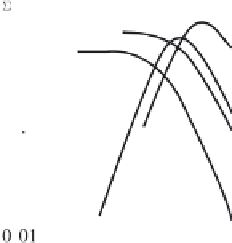Geoscience Reference
In-Depth Information
Fig. 2.35 Total energy of
waves due to piston-like and
membrane-like displacements
versus displacement duration.
The curves are numbered like
in Fig. 2.34
2
4
1
3
Fig. 2.36 Model of residual deformations of the bottom for a displacement alternating in sign
Analysis of space distribution of vertical residual displacements shows that at
the tsunami source there usually exist two regions: an elevation and a depression of
the ocean bottom [Van Dorn (1964); Dotsenko et al. (1986); Satake (1995); Kato,
Tsuji (1995)]. We shall term such a displacement alternating in sign. We shall briefly
dwell upon certain peculiarities of the directionality of wave emission, related to
such bipolar deformation of the ocean bottom. Consider the displacement alternat-
ing in sign to be described by the formula [Nosov et al. (1999)]:
η
4
(
x
,
y
,
t
)=
(
x
+
a
1
)
θ
(
x
)
η
1
a
−
1
1
(
x
+
a
1
)
−
θ
a
2
)
a
2
)
θ
η
2
a
−
1
2
+
(
x
−
(
x
)
−
θ
(
x
−
b
)
t
)
.
τ
−
1
τ
−
1
×
θ
(
y
+
b
)
−
θ
(
y
−
θ
(
t
)
−
(
t
−
τ
)
θ
(
t
−
τ
(2.114)
The space distribution of the deformation amplitude of the bottom, determined
by formula (2.114), is shown in Fig. 2.36. As to the time law of bottom deformation,
we consider a displacement with residual deformation.
The perturbation of a free surface in the case of a displacement alternating in sign
is calculated in accordance with the following formula:
ξ
4
(
x
,
y
,
t
)=
θ
(
t
)
ζ
4
(
x
,
y
,
t
)
−
θ
(
t
−
τ
)
ζ
4
(
x
,
y
,
t
−
τ
)
,






























